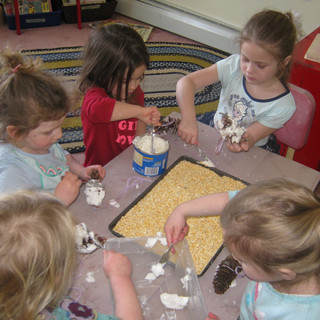Nurturing Nuance
- Tracy, Cheryl, and Tara
- Feb 11, 2018
- 3 min read
The world for children is often pretty black and white, and it's a way that they can gain some security. Bad guys are punished. Good guys live happily ever after. One of my roles as an adult in their lives is to help them realize that most of us live in a world of grays. Yes, we may try to be our best selves, but we fail and make mistakes all the time. Introducing these ideas into their free play, offering them glances at the complexities of history, and helping them to both forgive themselves and their friends for wrongs are all part of nurturing nuance in their lives.
Cheryl's PreK
Though we are finishing our five senses (what does Winter sound like - quiet or loud?) we will be continuing to use those senses to explore our natural world each day outside since we've become experts. We crafted bird feeders made from pine cones as we talked about how to be kind to animals who may have a hard time in winter finding food. We even placed one outside of our main classroom window to spy if the birds will be grateful. The concept of "family" has been introduced and we will delve into that theme in the coming weeks. A Family is a Family is a Family has us talking about all different kinds of families which led to a lively discussion about our very own families. Wild Family helped us understand that animals have families (and personalities) too and One Family had us counting family members. I love how one student pointed out that our rhyming read aloud from a prior week - The Seven Silly Eaters - had a different kind of family (very big!). I took the groups' interest to read that one again to everyone's glee (I love being able to do this). Each day these smallest children amaze me with their growth: from being detectives for words that start with the letter 'T' to practicing writing their own names. However, what I find most important for this age is allowing them the time and space to play - both outside in the snow (moved slides to land into a snow bank this week) and inside with the snow (in our sensory bin making houses for our family dolls or animals).
Our Theme: Revolutionary War
Before we delved too deeply into the Declaration of Independence, I wanted everyone to have a little grounding in the lives of the American colonists in the late 18th century. We looked at how their lives might be similar and different from our own by reading from If You Were There in 1776. We read accounts of the physical environment (think wilderness!) and everything from clothing to food choices. We also talked about the racial makeup of the population with 20 percent of the people being enslaved people from Africa. We talked about some of the colonists gripes with King George and introduced the idea of taxation without representation. We also defined "declaration" and "independence." Ask your child to share some details of what they learned. We read The Hatmaker's Sign a story by Benjamin Franklin retold by Candace Fleming. Franklin's story was intended to comfort Thomas Jefferson as the other politicians re-worked the words he had made for the Declaration of Independence. The children shared times when they had tried to collaborate with others and some of the challenges that presents.










































Comments